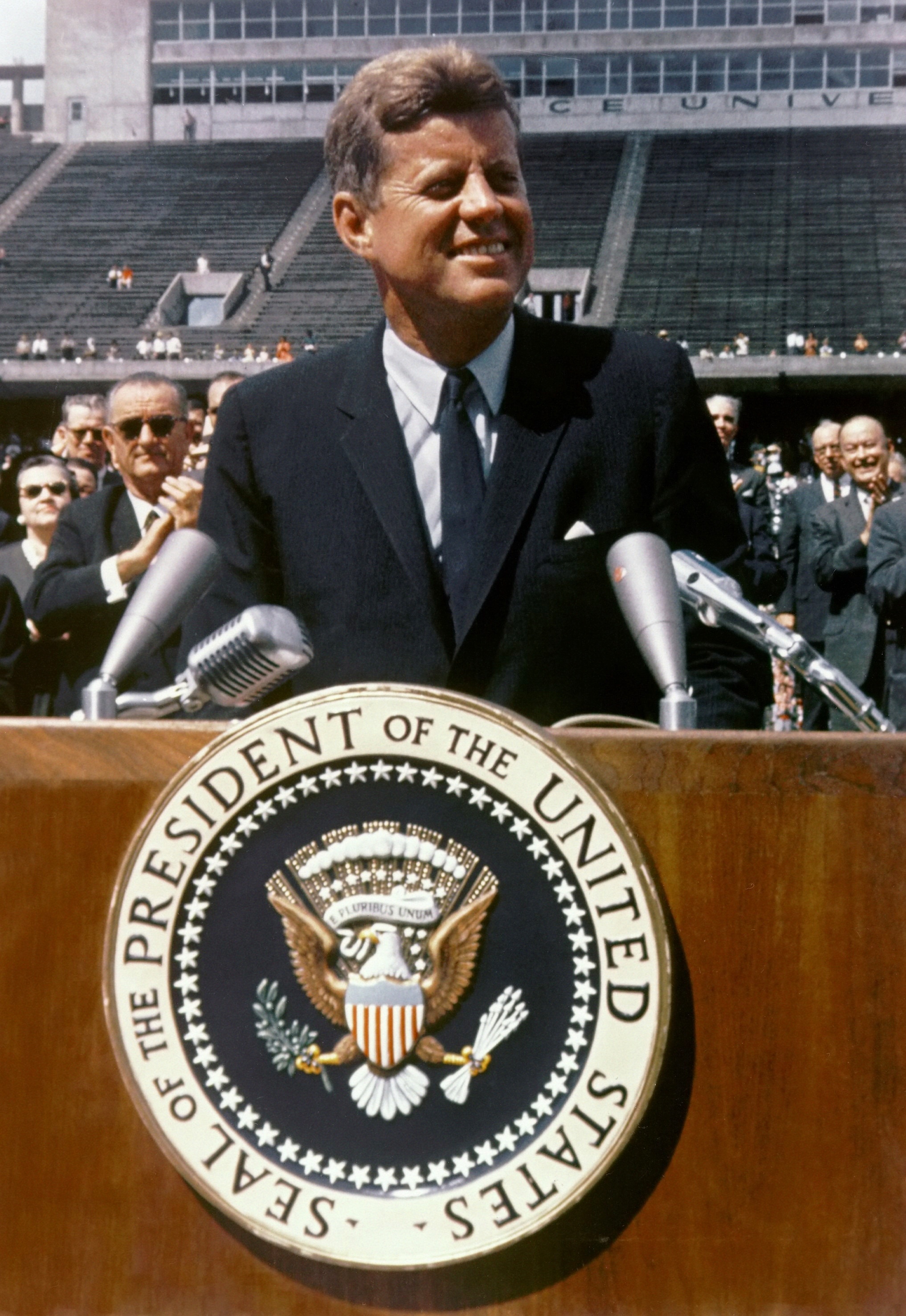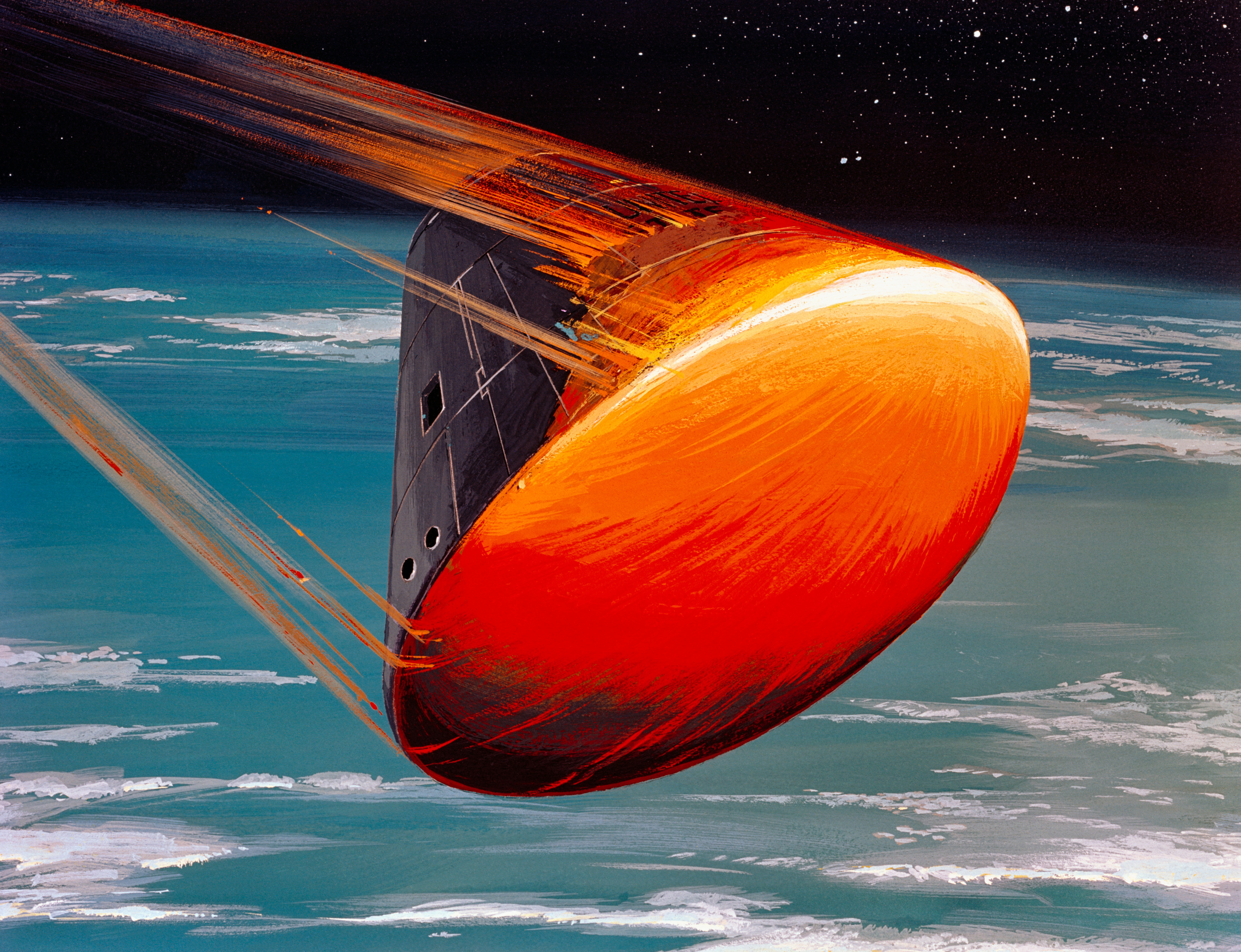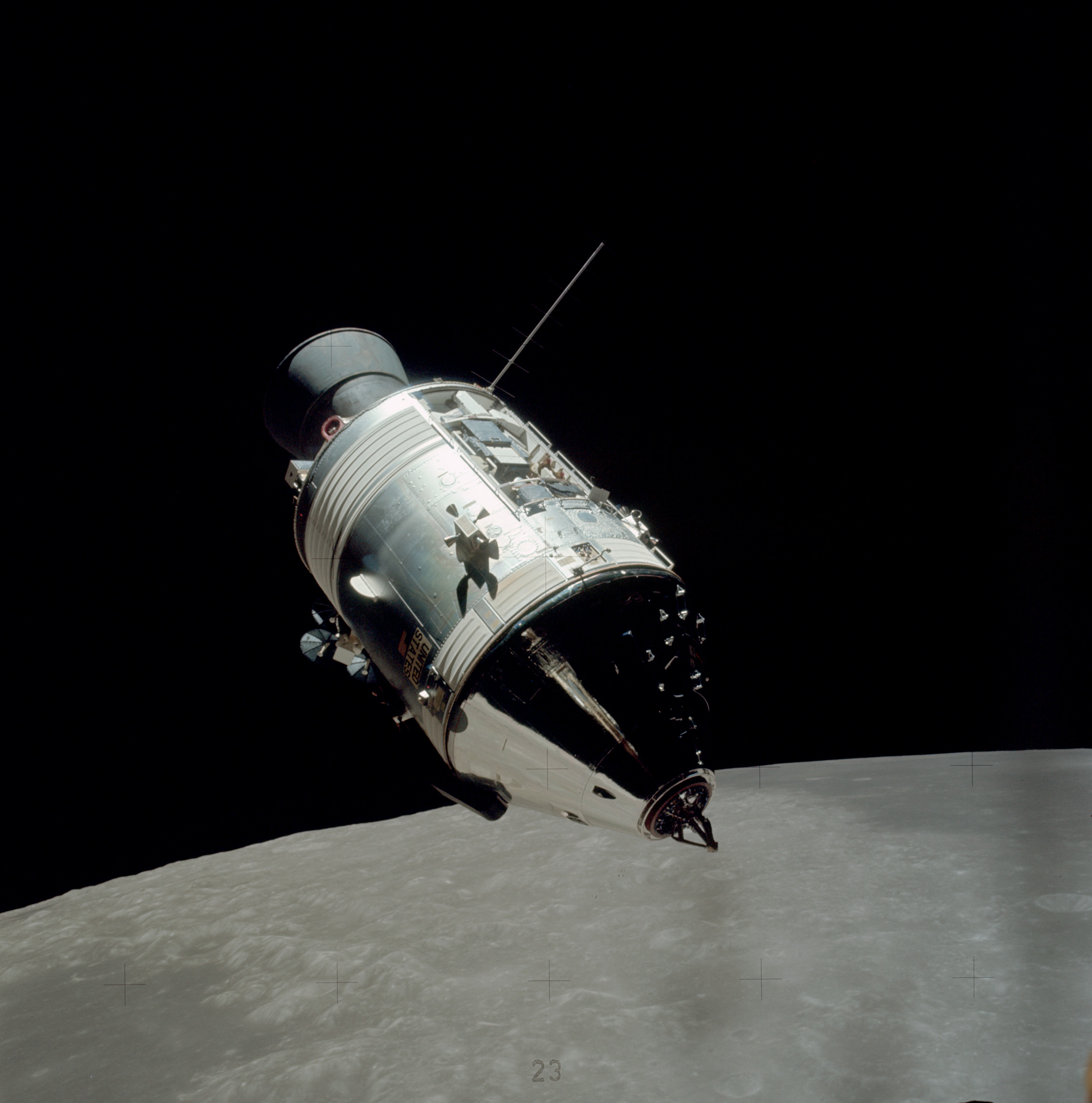|
Apollo 9
Apollo 9 (March 313, 1969) was the third human spaceflight in NASA's Apollo program. Flown in low Earth orbit, it was the second crewed Apollo mission that the United States launched via a Saturn V rocket, and was the first flight of the full Apollo spacecraft: the command and service module (CSM) with the Lunar Module (LM). The mission was flown to qualify the LM for lunar orbit operations in preparation for the first Moon landing by demonstrating its descent and ascent propulsion systems, showing that its crew could fly it independently, then rendezvous and dock with the CSM again, as would be required for the first crewed lunar landing. Other objectives of the flight included firing the LM descent engine to propel the spacecraft stack as a backup mode (as would be required on the Apollo 13 mission), and use of the portable life support system backpack outside the LM cabin. The three-man crew consisted of Commander James McDivitt, Command Module Pilot David Scott, ... [...More Info...] [...Related Items...] OR: [Wikipedia] [Google] [Baidu] |
Apollo Command And Service Module
The Apollo command and service module (CSM) was one of two principal components of the United States Apollo (spacecraft), Apollo spacecraft, used for the Apollo program, which landed astronauts on the Moon between 1969 and 1972. The CSM functioned as a mother ship, which carried a crew of three astronauts and the second Apollo spacecraft, the Apollo Lunar Module, to lunar orbit, and brought the astronauts back to Earth. It consisted of two parts: the conical command module, a cabin that housed the crew and carried equipment needed for atmospheric reentry and splashdown (spacecraft landing), splashdown; and the cylindrical service module which provided propulsion, electrical power and storage for various consumables required during a mission. An umbilical cable, umbilical connection transferred power and consumables between the two modules. Just before reentry of the command module on the return home, the umbilical connection was severed and the service module was cast off and all ... [...More Info...] [...Related Items...] OR: [Wikipedia] [Google] [Baidu] |
Apollo 8
Apollo 8 (December 21–27, 1968) was the first crewed spacecraft to leave low Earth orbit and the first human spaceflight to reach the Moon. The crew orbited the Moon ten times without landing, and then departed safely back to Earth. These three astronauts— Frank Borman, James Lovell, and William Anders—were the first humans to personally witness and photograph the far side of the Moon and an Earthrise. Apollo 8 launched on December 21, 1968, and was the second crewed spaceflight mission flown in the United States Apollo space program after Apollo7, which stayed in Earth orbit. Apollo8 was the third flight and the first crewed launch of the Saturn V rocket, and was the first human spaceflight from the Kennedy Space Center, located adjacent to Cape Kennedy Air Force Station in Florida. Originally planned as the second crewed Apollo Lunar Module and command module test, to be flown in an elliptical medium Earth orbit in early 1969, the mission profile was cha ... [...More Info...] [...Related Items...] OR: [Wikipedia] [Google] [Baidu] |
Apollo 13
Apollo 13 (April 1117, 1970) was the seventh crewed mission in the Apollo space program and the third meant to land on the Moon. The craft was launched from Kennedy Space Center on April 11, 1970, but the lunar landing was aborted after an oxygen tank in the service module (SM) failed two days into the mission. The crew instead looped around the Moon and returned safely to Earth on April 17. The mission was commanded by Jim Lovell, with Jack Swigert as command module (CM) pilot and Fred Haise as Lunar Module (LM) pilot. Swigert was a late replacement for Ken Mattingly, who was grounded after exposure to rubella. A routine stir of an oxygen tank ignited damaged wire insulation inside it, causing an explosion that vented the contents of both of the SM's oxygen tanks to space. Without oxygen, needed for breathing and for generating electric power, the SM's propulsion and life support systems could not operate. The CM's systems had to be shut down to conserve i ... [...More Info...] [...Related Items...] OR: [Wikipedia] [Google] [Baidu] |
Apollo 11
Apollo 11 (July 16–24, 1969) was the American spaceflight that first landed humans on the Moon. Commander Neil Armstrong and lunar module pilot Buzz Aldrin landed the Apollo Lunar Module ''Eagle'' on July 20, 1969, at 20:17 UTC, and Armstrong became the first person to step onto the Moon's surface six hours and 39 minutes later, on July 21 at 02:56 UTC. Aldrin joined him 19 minutes later, and they spent about two and a quarter hours together exploring the site they had named Tranquility Base upon landing. Armstrong and Aldrin collected of lunar material to bring back to Earth as pilot Michael Collins flew the Command Module ''Columbia'' in lunar orbit, and were on the Moon's surface for 21 hours, 36 minutes before lifting off to rejoin ''Columbia''. Apollo 11 was launched by a Saturn V rocket from Kennedy Space Center on Merritt Island, Florida, on July 16 at 13:32 UTC, and it was the fifth crewed mission of NASA's Apollo program. The Apollo spacecraft ha ... [...More Info...] [...Related Items...] OR: [Wikipedia] [Google] [Baidu] |
Docking And Berthing Of Spacecraft
Docking and berthing of spacecraft is the joining of two space vehicles. This connection can be temporary, or partially permanent such as for space station modules. ''Docking'' specifically refers to joining of two separate free-flying space vehicles. ''Berthing'' refers to mating operations where a passive module/vehicle is placed into the mating interface of another space vehicle by using a robotic arm. Because the modern process of un-berthing requires more crew labor and is time-consuming, berthing operations are unsuited for rapid crew evacuations in the event of an emergency. History Docking Spacecraft docking capability depends on space rendezvous, the ability of two spacecraft to find each other and station-keep in the same orbit. This was first developed by the United States for Project Gemini. It was planned for the crew of Gemini 6 to rendezvous and manually dock under the command of Wally Schirra, with an uncrewed Agena Target Vehicle in October 1965, but ... [...More Info...] [...Related Items...] OR: [Wikipedia] [Google] [Baidu] |
Space Rendezvous
A space rendezvous () is a set of orbital maneuvers during which two spacecraft, one of which is often a space station, arrive at the same orbit and approach to a very close distance (e.g. within visual contact). Rendezvous requires a precise match of the orbital velocities and position vectors of the two spacecraft, allowing them to remain at a constant distance through orbital station-keeping. Rendezvous may or may not be followed by docking or berthing, procedures which bring the spacecraft into physical contact and create a link between them. The same rendezvous technique can be used for spacecraft "landing" on natural objects with a weak gravitational field, e.g. landing on one of the Martian moons would require the same matching of orbital velocities, followed by a "descent" that shares some similarities with docking. History In its first human spaceflight program Vostok, the Soviet Union launched pairs of spacecraft from the same launch pad, one or two days apart ( ... [...More Info...] [...Related Items...] OR: [Wikipedia] [Google] [Baidu] |
Ascent Propulsion System
The ascent propulsion system (APS) or lunar module ascent engine (LMAE) is a fixed-thrust hypergolic rocket engine developed by Bell Aerosystems for use in the Apollo Lunar Module ascent stage. It used Aerozine 50 fuel, and oxidizer. Rocketdyne provided the injector system, at the request of NASA, when Bell could not solve combustion instability problems. Origins The LMAE traces its origin to the earlier Bell Aerosystems engines (8096, 8247) used in the RM-81 Agena, the rocket upper stage and satellite support bus developed by Lockheed initially for the canceled WS-117L reconnaissance satellite program. The Agena served as an upper stage for several defense, intelligence, and exploration programs: SAMOS-E, SAMOS-F (ELINT Ferret) and MIDAS (Missile Defense Alarm System) military early-warning satellites, Corona photo intelligence program, and the Ranger and Lunar Orbiter lunar probes. The Lockheed Agena target vehicle using the Bell 8247 engine was qualified for 15 rest ... [...More Info...] [...Related Items...] OR: [Wikipedia] [Google] [Baidu] |
Descent Propulsion System
The descent propulsion system (DPS - pronounced 'dips') or lunar module descent engine (LMDE), internal designation VTR-10, is a variable- throttle hypergolic rocket engine invented by Gerard W. Elverum Jr. and developed by Space Technology Laboratories (TRW) for use in the Apollo Lunar Module descent stage. It used Aerozine 50 fuel and dinitrogen tetroxide () oxidizer. This engine used a pintle injector, which paved the way for other engines to use similar designs. Requirements The propulsion system for the descent stage of the lunar module was designed to transfer the vehicle, containing two crewmen, from a circular lunar parking orbit to an elliptical descent orbit with a pericynthion of , then provide a powered descent to the lunar surface, with hover time above the lunar surface to select the exact landing site. To accomplish these maneuvers, a propulsion system was developed that used hypergolic propellants and a gimballed pressure-fed ablative cooled engine that w ... [...More Info...] [...Related Items...] OR: [Wikipedia] [Google] [Baidu] |
Flight Qualify
To flight-qualify is to take a product, process, or material and test it in order to prove that it will withstand the environment of aerodynamic or space flight. This process can include the following tests and processes: * parts screening * thermal test * vacuum test * vibration test or modal testing Modal testing is the form of vibration testing of an object whereby the natural (modal) frequencies, modal masses, modal damping ratios and mode shapes of the object under test are determined. A modal test consists of an acquisition phase and a ... * material analysis A flight qualification can include a test in the actual desired environment. References {{Space-stub Spaceflight Tests ... [...More Info...] [...Related Items...] OR: [Wikipedia] [Google] [Baidu] |
Command And Service Module
The Apollo command and service module (CSM) was one of two principal components of the United States Apollo spacecraft, used for the Apollo program, which landed astronauts on the Moon between 1969 and 1972. The CSM functioned as a mother ship, which carried a crew of three astronauts and the second Apollo spacecraft, the Apollo Lunar Module, to lunar orbit, and brought the astronauts back to Earth. It consisted of two parts: the conical command module, a cabin that housed the crew and carried equipment needed for atmospheric reentry and splashdown; and the cylindrical service module which provided propulsion, electrical power and storage for various consumables required during a mission. An umbilical connection transferred power and consumables between the two modules. Just before reentry of the command module on the return home, the umbilical connection was severed and the service module was cast off and allowed to burn up in the atmosphere. The CSM was developed and bu ... [...More Info...] [...Related Items...] OR: [Wikipedia] [Google] [Baidu] |
Apollo (spacecraft)
The Apollo spacecraft was composed of three parts designed to accomplish the American Apollo program's goal of landing astronauts on the Moon by the end of the 1960s and returning them safely to Earth. The expendable (single-use) spacecraft consisted of a combined command and service module (CSM) and an Apollo Lunar Module (LM). Two additional components complemented the spacecraft stack for space vehicle assembly: a spacecraft–LM adapter (SLA) designed to shield the LM from the aerodynamic stress of launch and to connect the CSM to the Saturn launch vehicle and a launch escape system (LES) to carry the crew in the command module safely away from the launch vehicle in the event of a launch emergency. The design was based on the lunar orbit rendezvous approach: two docked spacecraft were sent to the Moon and went into lunar orbit. While the LM separated and landed, the CSM remained in orbit. After the lunar excursion, the two craft rendezvoused and docked in lunar orbit ... [...More Info...] [...Related Items...] OR: [Wikipedia] [Google] [Baidu] |
Low Earth Orbit
A low Earth orbit (LEO) is an orbit around Earth with a period of 128 minutes or less (making at least 11.25 orbits per day) and an eccentricity less than 0.25. Most of the artificial objects in outer space are in LEO, with an altitude never more than about one-third of the radius of Earth. The term ''LEO region'' is also used for the area of space below an altitude of (about one-third of Earth's radius). Objects in orbits that pass through this zone, even if they have an apogee further out or are sub-orbital, are carefully tracked since they present a collision risk to the many LEO satellites. All crewed space stations to date have been within LEO. From 1968 to 1972, the Apollo program's lunar missions sent humans beyond LEO. Since the end of the Apollo program, no human spaceflights have been beyond LEO. Defining characteristics A wide variety of sources define LEO in terms of altitude. The altitude of an object in an elliptic orbit can vary significantly along the ... [...More Info...] [...Related Items...] OR: [Wikipedia] [Google] [Baidu] |
.jpg)
.jpg)







